Making My Bed(s); The “Best” Tomato
Buckwheat Beds
About a month ago the greenhouse was looking messy as oxalis, grasses, chickweed, and other weeds were starting to carpet the mostly bare ground. An unacceptable situation, considering that a month hence — now — I would need the space for planting in preparation for fall and winter.
The first step back in August was, obviously, to clear away the weeds, pulling almost each and every one out, roots and all. As long as weeds aren’t too overgrown or too abundant, the job is pleasantly satisfying. Moist soil also helps.
Pulling out weeds differs from the usual approach of preparing the soil by tilling it to discombobulate and bury weeds. I avoid tillage because it exposes buried weed seeds to light, which is just what new weeds need to germinate and grow. Tillage also burns up valuable humus and discombobulates not only the soil, but also resident fungi, earthworms, and other beneficial organisms.
I wasn’t ready to plant anything in some of those greenhouse beds a month ago, yet I hate to look at bare soil. (Mother Nature is equally repulsed by bare soil; she clothes it with weeds.) So I planted buckwheat, sprinkling the seeds thickly over the beds.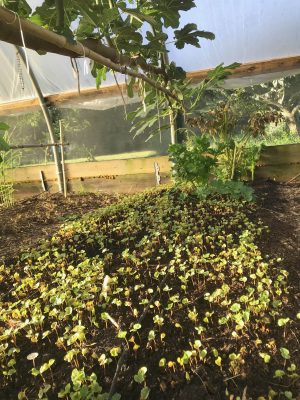 Buckwheat provides a quick and temporary cover of the bare ground. Sprinkling it with water assured its getting off to a quick start.
Buckwheat provides a quick and temporary cover of the bare ground. Sprinkling it with water assured its getting off to a quick start.
Finally, I covered the ground with an inch-thick layer of compost. That amount of compost will nourish whatever’s growing in the beds for a whole year. It also provides cover to hold moisture around the buckwheat.
Only a few days later, buckwheat sprouts were already peeking up through the compost blanket. They went on to grow quickly in the heat of the season. Aboveground the dense foliage was, I hoped, doing its job of shading out any new weeds trying sprout, something for which buckwheat is famous. 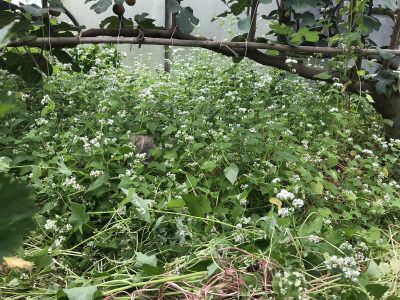 Below ground, the roots were latching onto nutrients that might otherwise leach away, bringing them up into the roots, stems, and leaves.
Below ground, the roots were latching onto nutrients that might otherwise leach away, bringing them up into the roots, stems, and leaves.
By the first week in September, buckwheat stems were flopping down onto the ground. Anyway, it was time to remove them to make way for planting the greenhouse. I was anxious to see what kind of new weed growth, if any, presented itself beneath the buckwheat.
The goal was to remove the buckwheat without disrupting the soil. My fingers easily raked off the tops which detached themselves from the roots that were left intact in the soil.
Buckwheat lived up to its reputation: I could hardly find a weed anywhere!
Oat Beds
Outdoor beds in the vegetable garden have been receiving similar treatment, with some wrinkles. Those beds that are finished for the season, not needed for autumn harvest, get cover crops of oats rather than buckwheat. Buckwheat doesn’t like cool weather and is killed by the slightest frost.
The advantage of oats over buckwheat is that oats enjoy cool weather, growing lush and green, and even tolerate quite a bit of cold weather. 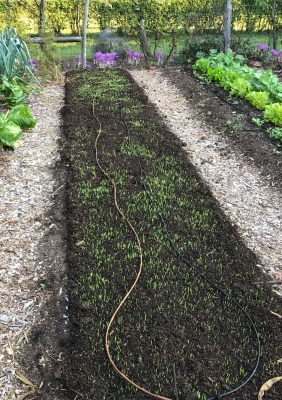 So any bed no longer needed for autumn vegetables and cleared before about the end of September gets oats (and compost). After the end of September, short days don’t provide enough light for the oats to grow enough to warrant planting.
So any bed no longer needed for autumn vegetables and cleared before about the end of September gets oats (and compost). After the end of September, short days don’t provide enough light for the oats to grow enough to warrant planting.
One benefit of oats, buckwheat, and any other cover crop is that they keep up appearances. 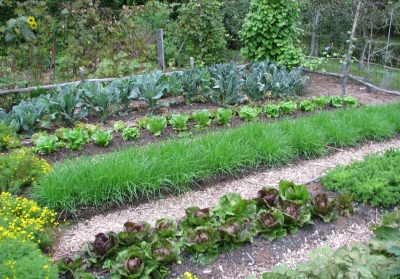 While I have great respect for soil, it’s not pretty to look at — and being bared isn’t good for the soil or the plants growing in it. I’d much rather look at a uniform, green carpet than bare, brown soil.
While I have great respect for soil, it’s not pretty to look at — and being bared isn’t good for the soil or the plants growing in it. I’d much rather look at a uniform, green carpet than bare, brown soil.
The Best(!!!!) Tomato
No need to rush summer vegetables out the door quite yet. I had the opportunity to try out a new tomato this season, Garden Gem, which has received a lot of fanfare.
Time travel back to 1995, when tomato breeder Harry Klee of the University of Florida, began to suss out what makes a great-tasting tomato using heirloom varieties, gas chromatography, and tasting panels. Then fast-forward to 2011, a field in Florida, where Harry tastes the result of his effort to breed a great-tasting tomato that is disease resistant and productive, and stands shipping. And so was born Garden Gem, the offspring of the luscious heirloom variety Maglia Rosa and the variety Fla. 8059, excellent in all characteristics except flavor.
Garden Gem scored as high as the heirloom parent for flavor.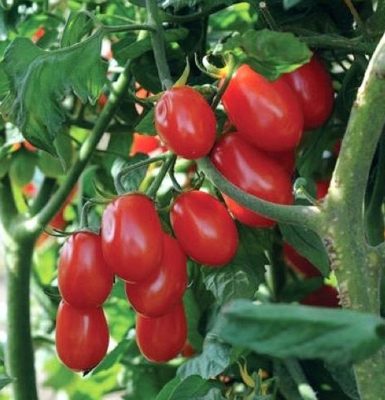 As it turns out, even taste is a matter of taste: To me, Garden Gem is not a great-tasting tomato; not even a good-tasting tomato. It lacked any sweetness or richness to smooth out the acidity, which is basically all I tasted.
As it turns out, even taste is a matter of taste: To me, Garden Gem is not a great-tasting tomato; not even a good-tasting tomato. It lacked any sweetness or richness to smooth out the acidity, which is basically all I tasted.
(The “perfect supermarket tomato,” as it was billed, was also a commercial flop, for now at least. It’s reported that Garden Gem too large for a small tomato and too small for a large tomato and, anyway, that consumers don’t really care about flavor.)

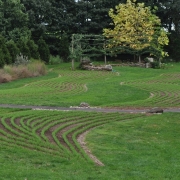

Hi Lee,
Have you tried Pink Princess? I had it in my garden this year and found it delicious! Just as good as, if not better than, sungold. For the first time I had a tomato that could go in a bowl on the table with sungold and get eaten!
I’m trying not to try out any new tomato varieties. But “as good as, if not better than, sungold”??!! That’s tempting. Where did you get the seed?
I know, I went through the same thing last year – I had just decided to take a break from most annuals and reduced tomato plans to only Sungold…and then read somewhere about Pink Princess, boy am I glad I decided to grow them. Last year I could only find them in two places, Fedco (was soldout) and Marianna’s Heirloom Seeds. I got my seeds from Marianna’s. It says it is a ‘Genepool’, but that info is from 2013 so I’m guessing it has been grown and selected a few times since. My 3 plants were all uniform. Everyone that tried them loved them, unfortunately my 4 year old got it in his head that only orange tomatoes are yummy (his experience from previous years) and refused to try them…
I grew both Garden Gem & Garden Treasure a couple years ago in Poughkeepsie.
I agree with you about Garden Gem – the taste was nothing special. Maybe our soil?Garden Treasure was better and unusually prolific for a 1/2 pound tomato. However there are equally good flavored beefsteaks which are much more available.
I have greenhouse envy as my lot is so planted up I have no room for even a little one. I am moving tenders into my sunroom for winter where they continue blooming … a trade off but crowded!!! V interesting about buckwheat
Please share info on your source for seeds and supplies.
I love reading your posts and want to follow in your footsteps,…
but am overwhelmed with decisions about which plants or seeds
will thrive here in the Hudson Valley.
At the beginning of Spring, do you make a giant order from Johnnies
for oat groats and buckwheat to have on hand? Do you go to your local Agway?
All of the berries that you write about,…where can I go to find them?
(thank you)
I buy most of my seeds from fedcoseeds.com. Some from Agway, including the oat cover crop seeds (sold as “feed oats” for horses). Buckwheat came online from some inexpensive source that I can’t remember. I propagate most of my fruit plants myself. When I buy them, usually from raintreenursery.com and cumminsnursery.com (both advertise on my blog page also).
Thanks for the update Lee, it’s a pleasure to read!
I’ve avoided cover crops because of my confusion about what happens after the cover crop has grown. Many resources recommend that tilling in the foliage as green manure, but I’m with you re: discombobulation. The buckwheat solution was to strip foliage by hand and leave the roots (the buckwheat won’t re-grow and compete with new plantings?). For oats, how will you manage the bed in the spring?
Finally, I heard from the author of a book on growing tomatoes that this year was his very first disappointing tomato year. I was encouraged by his admission, because it was a bad year for me too – usually I dismiss “bad year for x” as a lack of technical understanding mastery, but it seems to be the case this year with the prolonged wet and humid conditions. Flavor has disappeared from the tomatoes in all but my most extremely well-drained container-style bed.
Around here, the oat cover crop dies in January, with the tops flopping down on the ground like a mulch. By planting time in spring, you could plant through the thin mulch. Or — and this is what I do — just rake off the dead tops, which disconnect fro the dead roots, left in place. Then plant.
Yes, this year was a bad tomato year for me also in terms of yield. The flavor still seemed okay though.
Thanks for the response! I don’t usually delight in the misery of others, but it does feel good to know I’m not alone at least for yield on the tomatoes. One client reported great yield and flavor for her ‘Granadero’ Roma type tomatoes. Other than that, mostly bad news!
I attended my first Ohio PawPaw Festival this year and had a blast. Your name was mentioned during the lecture on the PawPaw’s tropical relatives and your books were recommended. I gorged on Paw
paw just about anything including Jerry Lehman’s fresh fruits. A wonderful experience!
I’ve been to Jerry’s farm; he really knows how to grow pawpaws, a persimmons!
I totally agree about Garden Gem–not worth growing.
I also trialed the other tomatoes from this Florida academic–Garden Treasure and “W”. Even grafted some of them to see the effect. Same result, poor flavor and poor germination, to boot. His Facebook page now blocks un-celebratory posts, so I image many others have wasted time and space on these varieties.